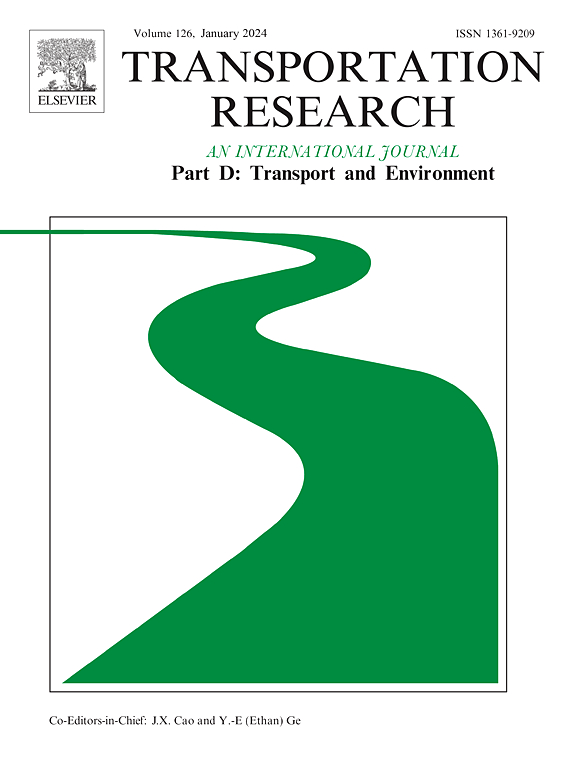Energy and environmental benefits of truck platooning for a busy freight corridor
IF 7.7
1区 工程技术
Q1 ENVIRONMENTAL STUDIES
Transportation Research Part D-transport and Environment
Pub Date : 2025-10-10
DOI:10.1016/j.trd.2025.105001
引用次数: 0
Abstract
Cooperative Truck Platooning Systems (CTPS) have been demonstrated, in controlled testing environments, to yield significant energy savings, while real-world trials have shown much lower benefits. A simulation-based study was undertaken for a busy freight corridor in Canada, to examine the potential fuel savings and emissions reductions associated with the introduction of CTPS, while accounting for many of the variables previously neglected in feasibility and economic analyses. Results demonstrate lower benefits than previously predicted, closer to those observed in on-road trials. Upwards of 6.5 % savings are possible for platoons no longer than four trucks with a minimum 15 m separation distance, with only 3.7 % overall savings when a 60 % usage rate is assumed. This provides emissions reductions of about 100 kT of CO per year (about 0.2 % of Canada’s current heavy-freight transportation emissions). Additionally, CTPS benefits are further reduced with precipitation- and location-based usage restrictions for the same simulation conditions.
繁忙货运通道中卡车队列的能源和环境效益
在可控的测试环境中,合作卡车队列控制系统(CTPS)已被证明可以显著节省能源,而实际试验显示其效益要低得多。针对加拿大一条繁忙的货运走廊进行了一项基于模拟的研究,以检查与引入CTPS相关的潜在燃油节约和减排,同时考虑到以前在可行性和经济分析中被忽视的许多变量。结果显示,效益低于先前的预测,更接近于在道路试验中观察到的结果。如果车队不超过4辆卡车,且间隔距离至少为15米,则可以节省6.5%以上的成本,而假设使用率为60%,则只能节省3.7%的成本。这将每年减少约100千吨二氧化碳的排放(约占加拿大目前重型货物运输排放量的0.2%)。此外,在相同的模拟条件下,基于降水和位置的使用限制进一步降低了CTPS的效益。
本文章由计算机程序翻译,如有差异,请以英文原文为准。
求助全文
约1分钟内获得全文
求助全文
来源期刊
CiteScore
14.40
自引率
9.20%
发文量
314
审稿时长
39 days
期刊介绍:
Transportation Research Part D: Transport and Environment focuses on original research exploring the environmental impacts of transportation, policy responses to these impacts, and their implications for transportation system design, planning, and management. The journal comprehensively covers the interaction between transportation and the environment, ranging from local effects on specific geographical areas to global implications such as natural resource depletion and atmospheric pollution.
We welcome research papers across all transportation modes, including maritime, air, and land transportation, assessing their environmental impacts broadly. Papers addressing both mobile aspects and transportation infrastructure are considered. The journal prioritizes empirical findings and policy responses of regulatory, planning, technical, or fiscal nature. Articles are policy-driven, accessible, and applicable to readers from diverse disciplines, emphasizing relevance and practicality. We encourage interdisciplinary submissions and welcome contributions from economically developing and advanced countries alike, reflecting our international orientation.

 求助内容:
求助内容: 应助结果提醒方式:
应助结果提醒方式:


